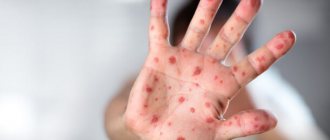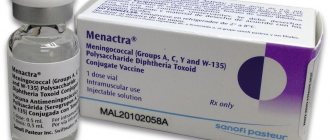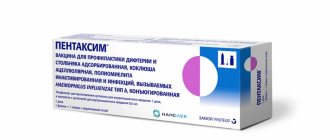Measles is an acute viral infection, which is characterized by fever, the development of catarrhal symptoms and the appearance of a specific rash. Measles is highly contagious. Transmitted from person to person by airborne droplets. The disease develops approximately 10 days after exposure.
Manifestations of the disease begin with fever, runny nose, and cough. Conjunctivitis and photophobia develop. From about 4 days of illness, a characteristic rash appears on the mucous membranes of the oral cavity and on the skin. The skin rash appears in stages starting from the head. Then moves on to the torso, arms and legs. By day 4, the rash begins to darken and peel. Then it disappears in the same sequence in which it appeared. There is no specific treatment for measles. Complications of infection occur in about a quarter of cases. These include: bronchitis, sinusitis, pneumonia and encephalitis.
Measles is a highly contagious infection; upon contact with a sick person, 9 out of 10 unvaccinated children become infected. The measles virus tends to infect the cells of the child’s immune system. This entails a high risk of infectious complications. In the pre-vaccination era, measles was one of the leading causes of child mortality. In addition, measles is often complicated by a disease of the nervous system. Measles encephalitis develops in approximately one in 300 affected children and has no specific treatment. Due to the high “infectiousness”, outbreaks of measles still occur in the world, especially in communities with low vaccination coverage.
Rubella is a viral infection characterized by mild catarrhal symptoms and the appearance of a rash. Rubella has a long incubation period. It takes 2-4 weeks from infection to the development of the disease. In this case, a person becomes infectious already in the middle of the incubation period and remains infectious after the rubella rash disappears. The first symptoms of the disease are nonspecific - a slight increase in temperature, a slight runny nose, weakness, and enlarged lymph nodes. After about 2 days of illness, a characteristic pinpoint bright rash appears. First on the head, then gradually descends to the limbs. After a few days, the rash goes away on its own without leaving a trace. Rubella in children is usually not severe. Rarely leads to complications.
Rubella has a mild course in children. However, due to the fact that the patient is contagious for a long time, even without a clinic, rubella spreads easily. Rubella infection is extremely dangerous for pregnant women, especially in the first trimester of pregnancy. In about a quarter of cases, women who have had rubella give birth to babies with one or another severe pathology. The most common of them is congenital cataracts (visual impairment, including blindness).
Mumps (mumps) is an acute infectious disease characterized by damage to the endocrine glands (usually the parotid salivary gland). The virus is transmitted by airborne droplets, less often by contact (from contaminated surfaces). The disease has a long incubation period - approximately 16-18 days. However, from the middle of the incubation period, the child can be contagious. The disease begins with a slight increase in temperature, general weakness, and dry cough. On days 2-3, the parotid salivary glands enlarge. After about a week, the size of the glands begins to decrease and the patient recovers. In some cases, recovery does not occur, complications appear - damage to the pancreas, mammary or gonads, nervous system, hearing impairment. It is important to note that mumps has no specific treatment.
Online consultation with pediatrician Olga Nikolaevna Tekutyeva
Registration online
During the consultation, you will be able to voice your problem, the doctor will clarify the situation, interpret the tests, answer your questions and give the necessary recommendations.
Mumps is often not severe and rarely causes complications. But these complications persist for life. These include infertility, deafness or the development of diabetes. In addition, those who have had mumps do not always develop immunity. The disease may recur in adulthood. The risk of complications in adults increases significantly.
Why are measles, rubella and mumps dangerous?
The main problem of these infections is the possibility of intrauterine infection of the fetus during the mother’s illness, when the consequences can be very serious both for the health of the baby and for the life of the unborn child. Severe symptoms in the sick person also cause a lot of inconvenience and trouble. It is worth considering in more detail how each of these infections manifests itself and what the threat is.
Previously, almost all children suffered from measles. The fact is that this disease is very contagious; if contact occurs with a patient, measles is transmitted in 95% of cases. In particularly severe cases of the disease, complications in the form of hepatitis, pneumonia and encephalitis are possible; rarely, measles can even lead to death. For pregnant women, the danger of getting measles is that in the early stages of pregnancy the disease increases the likelihood of developing dementia or mental retardation. The respiratory system suffers, which can lead to inflammation and death of the fetus. In late pregnancy, the disease can trigger early labor, and the baby becomes infected from the mother through the birth canal. As a result, characteristic rashes appear on the skin and mucous membranes. Since the child’s immunity is still weakened, complications in the form of encephalitis and pneumonia may develop against this background.
Regarding mumps, it should be noted that the infection can affect the membranes of the brain and spinal cord in approximately 15% of cases of development of the disease, one person in 20,000 people with mumps may experience deafness, in men and boys, mumps most often causes inflammation of the testicle and its appendages, in adult men – prostatitis. Doctors call pancreatitis, nephritis, oophoritis, mastitis and arthritis as rare but possible complications of mumps.
The main manifestations of rubella are a small rash, inflammation of the lymph nodes, and fever. But this is just the tip of the iceberg regarding the complexity of this disease. If a woman contracts rubella in the first trimester of pregnancy, there is an 80% chance that her child will have heart defects, mental retardation, deafness or cataracts at birth. But carrying the pregnancy to term will also be a problem for her - very often rubella can cause intrauterine fetal death or stillbirth.
In adulthood, the course of the disease can be very severe, with a large number of complications arising. But even in childhood it is better not to get sick with these infections. Immunity from the mother (innate immunity) is unstable and lasts only a few weeks after birth.
Measles-rubella-mumps vaccination
Young children should be vaccinated exactly at one year of age and again at the age of six. Revaccination of children at 6 years of age is necessary for the reason that not every body develops stable immunity from one vaccination.
In the future, revaccination is carried out at the age of 15-17 years in order to prevent serious health consequences:
- It is extremely necessary to extend protection against rubella for women planning pregnancy before pregnancy, since this disease is the most dangerous for this process.
- Immunity against measles acquired in childhood must be reactivated by receiving a new dose of the vaccine.
- It is important to prolong protection against mumps for men, since it is during adolescence that all the negative consequences for male reproductive function can occur when suffering from this infection.
In childhood, multicomponent vaccination is tolerated quite easily, the body rarely reacts to vaccination with severe conditions, and protection is fully formed. If a child was not vaccinated in early childhood, then he must receive the first vaccine at 13 years of age.
In modern medicine, there is a clear prescription for vaccination of adults with the above vaccine. For example, for those people who were born before 1957, vaccination is not indicated due to the fact that in all the years before, epidemics of this disease broke out everywhere, and people with a 90% probability have already suffered from the disease. All those who were born after 1957 and have not been vaccinated are recommended to receive two doses of a live vaccine, administered at intervals of 1 calendar month. This prescription is intended for adolescents, but 1 dose of vaccine is recommended for older adults.
For young women, the main goal should be mandatory vaccination against rubella, since this is the disease that has a very bad effect on the child if you get it during pregnancy. Rubella in the first 90 days of pregnancy often causes miscarriages and stillbirths. Other negative consequences include the birth of a child with congenital rubella syndrome, which is accompanied by the presence of developmental anomalies such as heart disease, cataracts and deafness. This syndrome may be accompanied by mental retardation, liver damage, kidney damage and other serious diseases.
An important point is the fact that the course of rubella can be in a latent form. In this case, the woman feels great, not paying attention to the minor rash, which goes away on its own after a few days. Meanwhile, the virus penetrates the placenta into the fetus, affecting all vital organs and systems. If a pregnant woman is suspected of having latent rubella, doctors carry out several stages of laboratory testing, the results of which should demonstrate the production of antibodies to this disease. If this occurs in the early stages, it is recommended to terminate the pregnancy to avoid the birth of a child with multiple deformities.
That is why, before planning a pregnancy, women who have not been ill should definitely take care of the appropriate vaccination, which protects against the disease 100% for the next 15 years. After vaccination, it is necessary to protect against pregnancy for another month.
Pregnant women are not specifically vaccinated, but sometimes vaccination occurs already during pregnancy. At the same time, the risk of intrauterine damage to the fetus is very low. As a rule, no changes in fetal development occur when vaccinated against rubella, which has been confirmed by numerous studies.
What should I do if I have a moderate or severe reaction?
What should you pay attention to?
- For any unusual condition, such as a high temperature or changes in behavior. Signs of a serious allergic reaction may include difficulty breathing, hoarseness or wheezing, hives, paleness, weakness, fast heartbeat, or dizziness.
What needs to be done?
- Call the doctor or take the patient to the doctor immediately.
- Tell your doctor what happened and the date and time the reaction occurred and the date and time you received the vaccine.
How to prepare for the measles-rubella-mumps vaccine
In order for successful vaccination without consequences and side effects, it is necessary to prepare for vaccination. The morning before vaccination, the child’s temperature is measured and his general well-being is determined. During a visit to the hospital, the person being vaccinated must be examined by a doctor, but before this, the child should not spend a long time in the same room with sick people, waiting for his turn. It is better if one parent sits in line, while the other takes a walk with the baby on the street. This way you can avoid infection with all kinds of viruses that do not have time to manifest themselves before vaccination. You may need to undergo some tests before vaccination if you have any suspicions about your child's health. On the eve of vaccination, it is not advisable to visit places with large crowds of people, especially when epidemics of viral infections are raging around.
Also, in preparation for vaccination, children with allergic manifestations are prescribed desensitizing drugs several days before vaccination. For children susceptible to colds, doctors recommend restorative medications 2 days before and 12 days after the planned vaccination.
For diseases of the nervous system, it is necessary to prepare especially carefully for vaccinations. For chronic diseases, on the eve of vaccination, it is necessary to consult a neurologist who can prescribe anticonvulsants. All children with chronic diseases can be vaccinated only during stable remission. If you are constantly taking special medications that support the body during chronic diseases, vaccination can be done along with such treatment.
Vaccination calendar
Modern vaccines against the infectious diseases in question are complex, allowing the body to immediately form immunity against the viruses of these diseases. However, there are mono-vaccines that are also sometimes used. The vaccination schedule provides for the first administration of a complex vaccine at the age of 1 year. Next, revaccination is carried out at 6 years, then from 15 to 17 years, from 22 to 29 years, and subsequently every 10 years.
In the absence of vaccination in early childhood, the first vaccination is usually given at the age of 13, and then from 22 to 29, and so on.
If the vaccination schedule was accidentally violated for objective reasons, you should:
- Get vaccinated as close as possible to the required schedule, observing a time interval between revaccinations of at least 4 years.
- If emergency prevention is necessary, after contact with a patient, you can vaccinate with the appropriate monovaccine. The three-component vaccine can be revaccinated 1 year after the introduction of such vaccines.
It is important to understand that numerous reviews about the dangers of vaccinations for the nervous system have led to a sharp increase in the percentage of unvaccinated children in some regions. However, according to medical data, the danger of the above diseases significantly exceeds the extremely rare complications from immunization. For example, in underdeveloped countries in Africa, about 745 thousand unvaccinated children still die from measles every year.
Why did the child become sick more often?
First of all, unusually close contact with a large number of children causes the spread of infectious diseases. Therefore, the child may begin to get sick more often.
This is how the child’s immune system “trains” practically in combat conditions. As a rule, children get sick less and less by school. However, if the child did not attend kindergarten, then in primary school he may begin to experience what his peers have already experienced: frequent colds and infectious diseases.
In addition to harmless colds, highly contagious infections become especially dangerous: influenza, measles, chickenpox, whooping cough, diphtheria, pneumococcal and meningococcal infections.
Vaccine injection site
The complex vaccine is administered in two ways - subcutaneously or intramuscularly. Children under three years of age are most often vaccinated in the outer thigh, and subsequently in the deltoid brachialis muscle.
The choice of such places for vaccination is explained by the fact that here the skin is very thin, there is little subcutaneous fat and the muscles are very close. When the vaccine gets into the fatty layer, it is deposited, enters the blood slowly and subsequently does not have the desired effect.
The buttocks are also not suitable for vaccine administration due to the inaccessibility of the gluteal muscles for the vaccination needle, due to the developed subcutaneous fat in these areas.
To help parents
To make vaccination go smoothly and easily, read our article “How to prepare for vaccination for both you and your child”
Remember, a child needs vaccinations not only because of the requirements of health workers at the clinic. If there is more than one child in a family, it is not uncommon for older children to “bring” an unexpected infection to the family from kindergarten or school, and children who have not yet had time to be vaccinated suffer. Vaccination is a protective line for all family members.
Take care of yourself and your loved ones in advance.
And be healthy!
Contraindications to vaccination against measles, rubella, mumps
Among all contraindications to vaccination against measles, mumps and rubella, there are 2 main groups - temporary and permanent.
Temporary specialists include:
- the presence of any diseases in the acute period;
- pregnancy period;
- use of gamma globulin and other blood products;
- vaccination or testing for antibodies to tuberculosis.
All these factors do not eliminate the need for vaccination, but require a short time period (on average 2 to 6 weeks) until the body’s condition stabilizes.
Among the constant and absolute contraindications, in which measles-rubella-mumps vaccination is impossible in principle, are:
- allergy to gentamicin, neomycin;
- allergy to egg whites;
- Quincke's edema;
- neoplasms of various types;
- the occurrence of complications due to previous vaccination;
- blood diseases accompanied by thrombocytopenia;
- HIV infection;
- various damage to the immune system (for example, the period after transplantation of any organs).
Preparations for vaccination
In our country, imported (Priorix, MMR-II) and domestic trivaccines are used. They contain laboratory-cultivated, live and weakened viruses from three infections. According to indications, a divaccine (against two infections) or vaccinations against only one disease can be administered. Drugs can be imported or domestic.
Sources:
- https://www.ncbi.nlm.nih.gov/pmc/articles/PMC6605874/ Hervé Haas, Patrick Richard, Cécile Eymin, Anne Fiquet, Barbara Kuter and Benoit Soubeyrand. Immunogenicity and safety of intramuscular versus subcutaneous administration of a combined measles, mumps, rubella, and varicella vaccine to children 12 to 18 months of age // Hum Vaccin Immunother. 2019; 15(4): 778–785.
- I.L. Solovyova, E.A. Alexandrova, E.M. Lezhen, O.V. Anosova, A.A. Solovyova. Vaccinal prevention of measles and mumps in children in modern conditions // Ulyanovsk Journal of Medical Biology, 2013, No. 4, pp. 47-53.
- N.V. Yuminova, E.O. Kontarova, N.V. Balaev, S.V. Artyushenko, N.A. Kontarov, N.V. Rossoshanskaya, E.S. Sidorenko, R.R. Gafarov, V.V. Zverev. Vaccinal prevention of measles, mumps and rubella: objectives, problems and realities // Epidemiology and Vaccinal Prevention, 2011, No. 4(59), pp. 40-44.
What not to do after vaccination
After immunization, the following rules must be observed:
- The first half hour after vaccination must be under the supervision of a doctor.
- Taking water procedures after vaccination is not prohibited, but it is not advisable to wet or rub the injection site for a long time, in order to avoid a local reaction.
- Introduce new, especially exotic, foods into the diet, the body’s reaction to which has not yet been studied.
- For a couple of days after vaccination, you should not be in crowded places so as not to become infected with a common ARVI and not confuse it with a reaction to the vaccine.
On the eve of vaccination, you should consult with your doctor about what medications you should have at home as an emergency and for the first symptoms of a reaction to the vaccine.
Reactions and complications to the measles-rubella-mumps vaccine
The measles component of a multicomponent vaccine has the greatest reactogenicity, that is, it causes specific conditions in the body. Among the most common reactions, doctors identify local redness or swelling at the injection site, which should subside over the next few days, coughing 6-11 days after vaccination, decreased appetite, nosebleeds, increased body temperature ranging from 37.2 to 39 degrees, rashes starting from the scalp and gradually moving to the torso.
The main complications of the measles component of a multicomponent vaccination include reactions that may appear 6-11 days after vaccination. Among them, the most common toxic reaction occurs when the child has a fever, his body temperature rises, the lymph nodes are inflamed, his throat is sore, weakness is pronounced and there is a rash on the body. Such symptoms go away no later than 5 days after their onset. Less commonly, convulsions occur as a complication, and post-vaccination encephalitis may develop. There are also allergic reactions in different forms - from mild to severe (Quincke's edema).
The mumps component of the vaccine is usually easily tolerated by children. Reactions to this component occur on day 8 and can progress until days 14-16. Within 3 days, the parotid salivary glands may become slightly enlarged, the throat may become red, a runny nose may occur, and the temperature may rise slightly.
Complications from mumps vaccination are extremely rare and are much more easily tolerated than the measles component. Toxic reactions are accompanied by a rise in temperature and a general deterioration in health. Allergic reactions occur only in those who are susceptible to allergic reactions. Damages to the nervous system with the mumps component are rare and are expressed in the occurrence of meningitis.
Children's reactions to the rubella component in the vaccine are usually quite weak and rare. They can be expressed in redness of the injection site, enlarged lymph nodes, a slight increase in body temperature, the occurrence of arthralgia, and joint pain.
Doctors call the appearance of a small reddish or purple rash as a complication of the rubella component in such a vaccine.
Why get vaccinated against rare diseases?
Indeed, some diseases on the list are extremely rare. And this is the merit of vaccination.
Success in the fight against infections has a downside - people stop getting vaccinated because they see a prosperous environment and fewer and fewer threats. Thus, contagious infections, which many have already forgotten about, may again come to the fore.
In Russia, an example of this phenomenon was the diphtheria epidemic in the mid-90s. It seemed that it was extremely rare, but a decrease in the number of vaccinations led to an increase in diseases - more than 100 thousand people. Mass vaccination of children made it possible to stop the epidemic.
Not long ago, many countries around the world experienced outbreaks of measles. In November 2021, WHO published data that there were 413,308 confirmed cases of the disease in 187 countries.
Also in 2019, outbreaks of meningococcal infection were recorded in Novosibirsk.
The only effective measure of protection against many infections is to take advantage of the achievements of modern medicine and maintain high vaccination coverage.
Possible reactions
If your body reacts to the measles, rubella and mumps vaccine, you should not worry, since this is an indicator of the activity of the human body's immune system. Such reactions do not require special treatment. It is important to remember that all reactions to this vaccine occur between 5 and 15 days after vaccination. All symptoms that occur at other times are not associated with vaccination and require additional diagnosis and appropriate treatment.
The most common reactions to a multicomponent vaccine are fever, minor rash, joint pain, runny nose and cough, pain at the injection site, which disappears on its own in a short time, without the use of additional therapy.
Fever
This is the most common post-vaccination symptom possible. The temperature generally rises to subfebrile levels, and in isolated cases can reach 39-39.5 degrees. In childhood, febrile convulsions may occur due to high fever. High temperature is absolutely not necessary for the immune system to work, so it should be reduced. Antipyretic drugs based on paracetamol and ibuprofen are recommended for children at home. The form of antipyretics can be any - from suppositories, syrups in children to syrups and tablets in adults.
Rash
Rashes can occur on any area of the skin. Common places where the rash is localized are the face, the area behind the ears, neck, arms, buttocks, and back. The rash resulting from a reaction to this vaccine is very small, all shades of pink, including one that is barely distinguishable from skin color. This rash should not be smeared or treated; it goes away on its own without any consequences. It is important to remember that the presence of a rash after vaccination does not indicate that the vaccinated person is contagious.
Joint pain
Joint pain most often occurs after vaccination at a later age. In 25% of vaccinated people over the age of 25, this symptom is present and is called reactive arthritis. Joint pain can last from a day to 3 weeks. They do not require emergency treatment.
Runny nose
Mild rhinitis may occur after vaccination on the 3rd day. It lasts from 1 to 14 days and causes virtually no inconvenience to the child. This type of runny nose does not require special treatment.
Cough
In the first couple of days, a slight cough may also occur, accompanied by a sore throat. This symptom disappears on its own without special treatment.
Enlarged lymph nodes
Since the mumps vaccine is live, it can cause lymphadenitis of the parotid lymph nodes. This symptom may last for about 2 weeks.
Complications
You need to know about rare complications of the multicomponent measles-rubella-mumps vaccine in advance in order to be able to react in time to emerging symptoms and be able to distinguish them from severe reactions to vaccination (which, we remind you, do not need to be treated, unlike complications).
So, complications include:
- Anaphylactic shock. It is a very rapid and severe manifestation of an allergic reaction that threatens the patient’s life. It develops on the egg white contained in the vaccine or antibiotics of a number of aminoglycosides. Toxic shock may also occur due to contamination of vaccine materials with staphylococci. These conditions require timely emergency treatment.
- Hives.
- Swelling of the injection site.
- Possible exacerbation of existing allergic reactions.
- Encephalitis occurs in children with pathologies of the nervous system or with too weak immunity.
- Meningitis also develops in neurologically compromised patients.
- Pneumonia, which is not a direct complication of vaccination, but only serves as a reflection of existing disorders in the functioning of the respiratory and digestive systems of the body, which worsen when a person’s immunity is diverted to the received vaccine.
- A decrease in platelet count in the blood is not dangerous and is asymptomatic and recovers over time.
- Stomach ache.
- Myocarditis.
- Glomerulonephritis.
How to prevent complications
To prevent unwanted complications after vaccination, general approaches must be taken. For example, people prone to allergies should be vaccinated together with the use of antiallergic drugs. Children with damage to the nervous system receive therapy along with the vaccine and for 2 weeks after its administration to prevent exacerbation of the underlying disease. Children who are regularly sick should take restoratives throughout the post-vaccination period. Before vaccination, you need to know if the patient has intolerance to egg white or aminoglycoside antibiotics, which is an absolute contraindication for vaccination. After vaccination, it is important to exclude multiple contacts that serve as a source of all kinds of infections.
Consequences of immunization
By the consequences of immunization with the measles-rubella-mumps vaccine, the World Health Organization means the occurrence of reactive arthritis. This anomaly often develops at a later age during immunization. A predisposition to such a disease may be rheumatism suffered at an early age or other systemic connective tissue diseases.
Post-vaccination arthritis worsens during cold seasons, and in the spring and summer the patient forgets about it. Such arthritis can be treated with anti-inflammatory drugs; it does not lead to a noticeable limitation of the functional activity of human joints.
Types of vaccines
The vaccine against the viruses in question comes in several types. The type of vaccine chosen by the doctor differs from analogues in the types of viruses included in the drug. All modern injections consist of typed viruses, which contribute to the guaranteed development of immunity to diseases. The vaccine is three-component, two-component and mono-, which indicates the complete interchangeability of injectable drugs with each subsequent revaccination.
Mono-vaccines
Ervevax
The Belgian monovaccine Ervevax helps fight the rubella virus, developing immunity within 15 days from the date of its administration. The effect of Ervevax lasts for 16 years. The vaccine can be used for children from 1 year of age.
Ervevax can be administered on the same day with DPT, DPT, polio, measles and mumps vaccines, provided that vaccination is performed in different parts of the human body. With other live vaccines, Ervevax can be administered with an interval of at least 1 month between injections.
Contraindications for the use of Ervevax:
- pregnancy;
- hypersensitivity;
- HIV infection;
- use of endogenous immunostimulants before vaccination with Ig preparations;
- acute and aggravated chronic diseases;
- allergic reactions to vaccine components.
Women of childbearing age can be vaccinated with Ervevax only if they do not plan to conceive a child within the next 3 months after vaccination.
Rudivaks
The French live attenuated rubella vaccine Rudivax forms appropriate immunity 15 days after injection. This immunity against rubella in humans lasts about 20 years. Contraindications to the use of this vaccine are the same factors as for Ervevax vaccination.
Measles cultural live dry vaccine (Russia)
The measles cultural live dry vaccine produced in Russia has a pronounced ability to stimulate the production of antibodies against measles in 95% of vaccinated people 28 days after administration. Immunity from vaccination lasts for 18 years.
Contraindications to the use of this vaccine are:
- acute and chronic diseases;
- HIV infection;
- neoplasms, malignant diseases of the circulatory system;
- allergy to aminoglycosides and quail egg protein.
Measles mono-vaccination is carried out at least 60 days after other vaccinations, and also no earlier than 90 days after and 2 weeks before the use of immunoglobulin or medications containing antibodies.
Ruvax (Aventis Pasteur, France)
The single-component French anti-measles drug Ruvax causes immunity against the virus 15 days after administration. This immunity lasts in the body for 20 years. The drug can be vaccinated in children from the age of nine months.
Contraindications to the use of Ruvax are:
- allergy to chicken egg white and neomycin;
- leukemia and other malignant diseases;
- immunodeficiency;
- corticosteroid, alkylating and antimetabolic therapy;
- radiation therapy;
- administration of immunoglobulin on the eve of vaccination.
LPV (live mumps vaccine)
The live mumps vaccine is designed to protect the body from mumps. The vaccine is administered from the age of 12 months. Emergency administration of the drug is possible to those who have been in contact with a patient with mumps (mumps) and have not been vaccinated before, no later than three days after such contact. Contraindications for VPV vaccination are the same symptoms and conditions as for Ruvax vaccination. You should also not vaccinate with VPV during pregnancy and breastfeeding.
Combined three-component vaccines
MMR II (measles, rubella, mumps)
The three-component American vaccine MMR-II is quite popular because it forms immunity to 3 viruses at once - measles, rubella and mumps. With its help, antibodies to the measles virus are produced in 98% of people, and to mumps and rubella - in 96.1% and 99.3%, respectively. It is compatible with DTP, DPT, polio, Haemophilus influenzae type B and chickenpox vaccines. These injections can be done on the same day, but in different parts of the body.
Contraindications to the use of MMR-II are pregnancy, sensitivity to neomycin, chicken proteins, HIV infection, viral and chronic diseases in an acute state.
Priorix (measles, rubella, mumps)
The Belgian three-component vaccine Priorix is very effective against measles, mumps and rubella. This vaccine is highly purified, making reactions to its administration less pronounced than to other similar vaccines.
Among the main contraindications to the use of Priorix, doctors identify:
- high sensitivity to chicken egg white and neomycin;
- neomycin contact dermatitis;
- HIV infection;
- ARVI, acute stomach diseases;
- exacerbation of infectious, viral and chronic diseases;
- pregnancy.
Two-component drug
Among two-component vaccines, the most common are domestic vaccines - mumps-measles and measles-rubella vaccine. It is important to remember that when vaccinated with these drugs, it will be necessary to carry out additional vaccination with a single-component vaccine against a disease that is not covered by this vaccination.
Mumps-measles vaccine (Russia)
The domestically produced mumps-measles vaccine can be administered to children from the age of 12 months to form stable immunity to mumps and measles. Revaccination with this drug is prescribed upon reaching the age of 6 years.
Among the main contraindications for the use of this two-component vaccination are:
- anaphylactic and allergic reactions;
- neoplasms and malignant diseases of the circulatory system;
- severe reactions to previous vaccination with such a drug;
- pregnancy and breastfeeding;
- acute viral or exacerbated chronic diseases.
Measles-rubella vaccine
Best materials of the month
- Coronaviruses: SARS-CoV-2 (COVID-19)
- Antibiotics for the prevention and treatment of COVID-19: how effective are they?
- The most common "office" diseases
- Does vodka kill coronavirus?
- How to stay alive on our roads?
This vaccine has all the same properties as the domestically produced mumps-measles vaccine. It requires the additional introduction of a monovaccine against mumps for comprehensive protection of the human body.
Infections included in the Calendar for epidemic indications
In addition to the mandatory vaccinations of the National Calendar, there are infections against which vaccinations are required due to occupational, territorial and other epidemic risks. Below is a list of diseases and medications for such indications.
Rabies
The pathology is viral in nature. It affects the central nervous system, leading to paralysis, phobias, hallucinations, and aggression. May cause death. The source and reservoir of the virus are wild carnivores, especially foxes and wolves, as well as dogs and cats; and in the countries of America - bats. A person becomes infected through a bite, salivation of damaged skin or mucous membranes, rarely through objects contaminated with saliva, when cutting animal carcasses, etc.
Vaccines and specific immunoglobulins are used against rabies:
• KOKAV – rabies vaccine, cultured, dry, concentrated, purified, inactivated, Russia; • Rabivak-Vnukovo-32 (KAV) – rabies culture inactivated dry vaccine, Russia; • Rabipur – rabies vaccine, GlaxoSmithKline, Germany; • Rabies immunoglobulin from human serum, Sichuan Yuanda Shuyang, China; • Anti-rabies immunoglobulin from horse serum, Russia, Ukraine.
Brucellosis
A zoonotic infection caused by a microorganism of the genus Brucella. Complications include: pericarditis, damage to the ovaries and testicles, polyarthritis, termination of pregnancy and other pathologies. A person becomes infected through contact with sick animals or their secretions, as well as through consumption of infected unpasteurized milk and/or dairy products. Professional groups (persons over 18 years of age) are subject to vaccination.
Used:
• Live dry brucellosis vaccine, Russia.
Typhoid fever
Bacterial intestinal infection, more typical for ages from 5 to 19 years. It occurs in an acute form and has a cyclical course. Affects the intestinal lymphatic system. Among the main symptoms: manifestations of acute intoxication (high body temperature, fever, disturbances in sleep, appetite, stool), profuse rashes in the abdomen and lower chest, bradycardia, decreased blood pressure. May cause meningitis, thrombophlebitis, pneumonia.
Typhoid vaccines registered in Russia:
• TIFIVAK – dry alcoholic typhoid vaccine, Russia (use – from 18 years of age); • VIANVAK – typhoid vi-polysaccharide liquid vaccine, Russia (use – from 3 years); • VIVAXIM (preparing for registration).
Viral hepatitis A
A disease caused by the hepatitis A virus, which attacks liver cells. The disease occurs in an acute form, and if the course is uncomplicated, it goes away within two weeks. The pathogen is transmitted by the fecal-oral route. Among the main symptoms: darkening of urine, yellowing of the skin, mucous membranes, sclera, colorless feces. Severe hepatitis A can cause chronic pancreatitis, cholecystitis, and biliary dyskinesia.
The following vaccines are registered in Russia:
• GEP-A-in-VAK – vaccine against hepatitis A, culture-based, purified, concentrated, adsorbed, inactivated liquid, Russia (use from 3 years of age); • GEP-A-in-VAK-POL – vaccine against hepatitis A, cultural purified concentrated adsorbed inactivated liquid with polyoxidonium, Russia (use from 3 years); • “Algavac®M” – hepatitis A vaccine, culture-based, purified, concentrated, adsorbed, inactivated liquid, JSC “Vector-Bialgam”, Russia (use – from 3 years); • Avaxim 80, Sanofi Pasteur, France (use - from 12 months to 15 years); • Avaxim, Sanofi Pasteur, France (use – over 16 years); • Vaqta® 25 Ud. and 50 units. Merck, Sharp and Dome, USA (use from 2 years); • Havrix 720, GlaxoSmithKline, Belgium (from 12 months to 15 years); • Havrix 1440, GlaxoSmithKline, Belgium (over 16 years).
Sonne dysentery
This is the most common form of dysentery in Russia. The causative agent is a bacterium that affects the large intestine. Vaccinated against body intoxication, diarrhea. The main cause of infection is failure to comply with personal hygiene rules.
Used:
• SHIGELLVAK – dysentery vaccine against Shigella Sonne, lipopolysaccharide liquid, Russia.
Yellow fever
It is an acute viral disease that is transmitted through a mosquito bite. It is characterized by a severe course with a predominance of symptoms of intoxication. Through the bloodstream, the virus penetrates all organs, leading to cell degeneration. Complications include: inflammation of the kidneys, brain, and lungs. Possible death.
Used:
• Live dry yellow fever vaccine, Russia. The vaccine is the only one that is included in the International Certificate and is required when traveling to endemic regions. Can be used from 9 months of age.
Covid (COVID-19)
COVID-19 (coronavirus) is a viral disease that primarily affects the respiratory system. It can be mild or severe, or asymptomatic. Basically, the signs of coronavirus are similar to those of other colds (flu, acute respiratory infections). These are: dry cough, fever, weakness). In the absence of timely treatment, especially in severe cases, the pathology leads to death.
Covid vaccines registered in Russia:
• Gam-Covid-Vac (Sputnik V) • EpiVacCorona • Covivac • Convidia
Tick-borne encephalitis
An acute viral disease that affects cells of the nervous system. the source of infection is the ixodid tick. The disease can occur lightning fast or in a protracted form. In the first case, the likelihood of death is especially high. Symptoms appear suddenly: headache, vomiting, high fever. Tick-borne encephalitis is endemic in forest and taiga zones.
Tick-borne encephalitis vaccines registered in Russia:
• Vaccine of tick-borne encephalitis, culture purified concentrated inactivated dry, IPVE named after. M.P. Chumakova, Russia, Moscow (for children over 3 years old and adults); • EnceVir (from 18 years old) – tick-borne encephalitis vaccine, cultured, purified, concentrated, inactivated, sorbed liquid, Microgen, Russia, Tomsk; • EnceVir® Neo for children - vaccine against tick-borne encephalitis (inactivated), Microgen, Russia, Tomsk; • Tick-E-Vac for children – tick-borne encephalitis vaccine, culture purified, concentrated, inactivated, sorbed, IPVE named after. M.P. Chumakova, Russia, Moscow (for children from 1 year to 16 years); • Tick-E-Vac for adults – tick-borne encephalitis vaccine, culture purified, concentrated, inactivated, sorbed, IPVE named after. M.P. Chumakova, Russia, Moscow (for persons over 16 years old); • FSME-IMMUN® Inject, Baxter, Austria (for persons over 16 years old); • FSME-IMMUN® Junior, Baxter, Austria (for children from 1 year to 16 years); • Encepur-adult, Novartis, Germany (for persons over 12 years old); • Encepur-children, Novartis, Germany (for children from 1 year to 12 years).
Q fever
A disease caused by a microorganism. Distributed mainly in pastoral areas. Human infection occurs through airborne droplets and airborne dust through contact with animals, tick bites, and consumption of milk. Leads to severe intoxication and lung damage.
For vaccination it is used:
• Q fever vaccine M-44 live dry cutaneous, Russia.
Leptospirosis
The source may be farm animals and dogs. As a rule, infection occurs when swimming in bodies of water with contaminated water. The disease leads to the development of severe intoxication, damage to the liver, kidneys, and muscle tissue.
Used:
• Leptospirosis vaccine concentrated inactivated liquid polyvalent, Russia.
Meningococcal infection
Acute infection caused by meningococcus. It can occur with or without pronounced symptoms (latent carriage). It has different forms and different symptoms. It is characterized by both rapid recovery and the development of severe complications. Children under 5 years of age are most often affected.
The following vaccines are registered in Russia:
• Meningococcal polysaccharide vaccine A, Russia (from 1 year to 8 years; from 9 years and older); • Meningo A+C polysaccharide, Sanofi Pasteur, France (use from 18 months); • Mencevax ACWY polysaccharide, GlaxoSmithKline, Belgium (used from 2 years); • Menugate® – diphtheria toxoid-conjugated vaccine against meningococcal infection caused by group C meningococcus, Novartis, Italy (use from 2 months); • Menactra – meningococcal polysaccharide vaccine (serogroups A, C, Y and W-135) conjugated with diphtheria toxoid, Sanofi Pasteur, USA (use from 9 months).
anthrax
A dangerous bacterial disease that occurs in an acute form. Infection occurs through contact with a sick animal, contaminated animal products or the remains of dead animals. The spores are highly resistant and can spread over long distances. It occurs in cutaneous, intestinal and the most severe pulmonary forms, the latter developing during inhalation infection.
Vaccines used in Russia:
• Dry live anthrax vaccine for subcutaneous and scarification use, Russia; • Anthrax vaccine combined dry and liquid for subcutaneous use, Russia.
Tularemia
Acute infectious disease. Affects the lymphatic system and internal organs. symptoms depend on the form of the disease. People who have contact with animals are mainly infected, but infection is possible by consuming contaminated meat and water, or by bites from ticks and other vectors. In Russia, there are isolated cases of tularemia (in 2010 - 115 cases, of which 14 were in children).
Licensed in Russia:
• Live dry tularemia vaccine, Russia.
Cholera
Acute bacterial disease. Affects the intestines. Causes vomiting and diarrhea, which quickly lead to dehydration. Currently, cholera often occurs in a latent form, which can ultimately lead to serious complications and even death.
Used:
• Cholera vaccine bivalent chemical tablets, Russia.
Plague
An infectious disease of a bacterial nature. The course is acute and severe. It occurs with severe signs of intoxication, damage to the lymphatic system, lungs, and other organs.
Are used:
• Live dry plague vaccine for oral use (from 14 years), Russia; • Live dry plague vaccine, Russia (use for children from 6 months to 6 years and adults over 60 years).
Chicken pox – herpes zoster
Acute disease of viral origin. The source of infection is an infected person. One of the main signs of the disease is a rash that gradually spreads throughout the body. In addition, the pathology is accompanied by headaches, itching, weakness, fever and other symptoms. It is a highly contagious disease.
Vaccines:
• Varilrix – live vaccine, GlaxoSmithKline, England; • Okavax – live vaccine from the Oka strain, Biken Institute, Japan (no supply).
Herpes infection types I and II
The causative agent is herpes virus types 1 and 2. The disease has a chronic course with periods of relapse. Affects skin and mucous membranes. Symptoms depend on the location of the virus, the person’s immune system, age and other factors.
Vaccines:
• VITAGERPVAK, VITAPHARMA, Russia.
Human papillomavirus (HPV) infection
The human papillomavirus (HPV) causes malignant transformation of cells. Of the more than 120 types of human papillomavirus, more than 30 types infect the genital tract. In addition, HPV is the cause of diseases such as recurrent respiratory papillomatosis in children and adults, genital warts. Most cases of infection occur without symptoms, but quite often changes in the infected mucous membranes progress to the development of papilloma or cancer.
Vaccines registered in Russia:
• GARDASIL®, quadrivalent, Merck Sharp and Dome B.V., USA. • Quadrivalent vaccine against human papillomavirus (HPV types 6, 11, 16 and 18). • CERVARIX, bivalent, GlaxoSmithKline, Belgium.
Rotavirus infection
This group of diseases includes pathologies caused by rotavirus. These are diseases in which the mucous membrane of the stomach and intestines is damaged. Mostly children get sick. Rotavirus is characterized by symptoms such as vomiting, diarrhea, symptoms of intoxication, and possible muscle cramps. If not treated promptly, the disease can be fatal.
Vaccines:
• Rotarix® oral live monovalent vaccine, GlaxoSmithKline, Belgium (use from 6 weeks of age to 24 weeks). • RotaTek® - oral live 5-valent reassortant vaccine, Merck, Sharp and Dome, the Netherlands (for children from 6 weeks). Entered 3 times.
Pseudomonas infection
The disease is caused by Pseudomonas aeruginosa. Pathology refers to nosocomial infections. May cause damage to the upper respiratory tract and internal organs. Active reproduction of Pseudomonas aeruginosa in the human body is associated mainly with the poor state of the immune system. High-risk groups include newborns, children under 7 years of age, elderly patients, as well as patients with leukemia and other tumors, patients with degenerative diseases, patients in the early postoperative period and patients with widespread and severe burns.
A vaccine has been registered in Russia for the prevention of Pseudomonas aeruginosa infection
• “Psevdovak” (JSC IBSV “BIOMED”, Russia).
According to WHO, today approximately 25% of patients worldwide die from infectious diseases. WHO names tourism as one of the main factors leading to a significant spread of infections. When traveling to any country, you should definitely ask what diseases are most dangerous there and whether there is a vaccine for them. Among the above vaccines, not all are available for use in Russia. However, even this list is quite enough to protect yourself and your loved ones from serious and deadly diseases.







